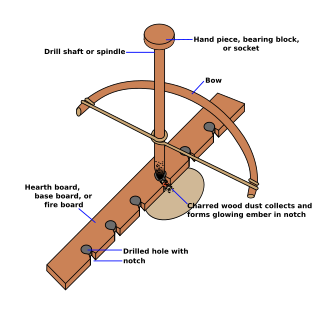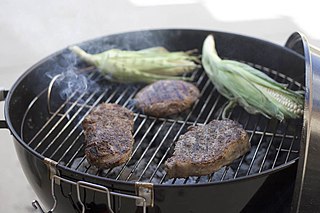A fire drill is a device to start a fire by friction between a rapidly rotating wooden rod (the spindle or shaft) and a cavity on a stationary wood piece (the hearth or fireboard). [1] [2] [3]
The device can be any of the ancient types of hand-operated drills, including a hand drill, bow drill (or strap drill), or pump drill. The spindle is usually 1–2 cm thick and ends in a dull point. The spindle and fireboard are typically made from dry, medium-soft non-resinous wood such as spruce, cedar, balsam, yucca, aspen, basswood, buckeye, willow, tamarack, or similar. [4]
Whatever the method used to drive the shaft, its lower end is placed into a shallow cavity of the fireboard with "V" notch cut into it. The primary goal is to generate heat by the friction between the tip of the shaft and the fireboard. controlled by rotation speed and pressure. The heat eventually turns the wood at the point of contact into charcoal, which is ground to a powder by the friction, that collects into the "V" notch. Continuing operation eventually ignites the charcoal dust producing a tiny ember, which can be used to start a fire in a "tinder bundle" (a nest of stringy, fluffy, and combustible material). [4]
Other methods of include drilling partway into a hearth made by lashing two sticks together from one side, and then drilling from the other side to meet this hole; or using the area where two branches separate. This is to keep the coal off wet or snow-covered ground.[ citation needed ]

A bow drill is a simple hand-operated type of tool, consisting of a rod that is set in rapid rotary motion by means of a cord wrapped around it, kept taut by a bow which is pushed back and forth with one hand. This tool of prehistoric origin has been used both as a drill, to make holes on solid materials such as wood, stone, bone, or teeth, and as a fire drill to start a fire.

A lathe is a machine tool that rotates a workpiece about an axis of rotation to perform various operations such as cutting, sanding, knurling, drilling, deformation, facing, and turning, with tools that are applied to the workpiece to create an object with symmetry about that axis.
A crusher is a machine designed to reduce large rocks into smaller rocks, gravel, sand or rock dust.

A drill is a tool used for making round holes or driving fasteners. It is fitted with a bit, either a drill or driver chuck. Hand-operated types are dramatically decreasing in popularity and cordless battery-powered ones proliferating due to increased efficiency and ease of use.

Metalworking is the process of shaping and reshaping metals to create useful objects, parts, assemblies, and large scale structures. As a term it covers a wide and diverse range of processes, skills, and tools for producing objects on every scale: from huge ships, buildings, and bridges down to precise engine parts and delicate jewelry.

A barbecue grill or barbeque grill is a device that cooks food by applying heat from below. There are several varieties of grills, with most falling into one of three categories: gas-fueled, charcoal, or electric. There is debate over which method yields superior results.

A speargun is a ranged underwater fishing device designed to launch a tethered spear or harpoon to impale fish or other marine animals and targets. Spearguns are used in sport fishing and underwater target shooting. The two basic types are pneumatic and elastic. Spear types come in a number of varieties including threaded, break-away and lined. Floats and buoys are common accessories when targeting larger fish.

Drilling is a cutting process where a drill bit is spun to cut a hole of circular cross-section in solid materials. The drill bit is usually a rotary cutting tool, often multi-point. The bit is pressed against the work-piece and rotated at rates from hundreds to thousands of revolutions per minute. This forces the cutting edge against the work-piece, cutting off chips (swarf) from the hole as it is drilled.

Woodturning is the craft of using a wood lathe with hand-held tools to cut a shape that is symmetrical around the axis of rotation. Like the potter's wheel, the wood lathe is a mechanism that can generate a variety of forms. The operator is known as a turner, and the skills needed to use the tools were traditionally known as turnery. In pre-industrial England, these skills were sufficiently difficult to be known as "the mysteries of the turners' guild." The skills to use the tools by hand, without a fixed point of contact with the wood, distinguish woodturning and the wood lathe from the machinist's lathe, or metal-working lathe.

Fire making, fire lighting or fire craft is the process of artificially starting a fire. It requires completing the fire triangle, usually by heating tinder above its autoignition temperature.

A spindle is a straight spike, usually made from wood, used for spinning, twisting fibers such as wool, flax, hemp, cotton into yarn. It is often weighted at either the bottom, middle, or top, commonly by a disc or spherical object called a whorl; many spindles, however, are weighted simply by thickening their shape towards the bottom, e.g. Orenburg and French spindles. The spindle may also have a hook, groove, or notch at the top to guide the yarn. Spindles come in many different sizes and weights depending on the thickness of the yarn one desires to spin.

A dental drill or dental handpiece is a hand-held, mechanical instrument used to perform a variety of common dental procedures, including removing decay, polishing fillings, performing cosmetic dentistry, and altering prostheses. The handpiece itself consists of internal mechanical components which initiate a rotational force and provide power to the cutting instrument, usually a dental burr. The type of apparatus used clinically will vary depending on the required function dictated by the dental procedure. It is common for a light source and cooling water-spray system to also be incorporated into certain handpieces; this improves visibility, accuracy and overall success of the procedure. The burrs are usually made of tungsten carbide or diamond.

A screw is a mechanism that converts rotational motion to linear motion, and a torque to a linear force. It is one of the six classical simple machines. The most common form consists of a cylindrical shaft with helical grooves or ridges called threads around the outside. The screw passes through a hole in another object or medium, with threads on the inside of the hole that mesh with the screw's threads. When the shaft of the screw is rotated relative to the stationary threads, the screw moves along its axis relative to the medium surrounding it; for example rotating a wood screw forces it into wood. In screw mechanisms, either the screw shaft can rotate through a threaded hole in a stationary object, or a threaded collar such as a nut can rotate around a stationary screw shaft. Geometrically, a screw can be viewed as a narrow inclined plane wrapped around a cylinder.
The Hawaiian sling is a device used in spearfishing. The sling operates much like a bow and arrow does on land, but energy is stored in rubber tubing rather than a wooden or fiberglass bow.

A kamado is a traditional Japanese wood- or charcoal-fueled cook stove.
The control of fire by early humans was a critical technology enabling the evolution of humans. Fire provided a source of warmth and lighting, protection from predators, a way to create more advanced hunting tools, and a method for cooking food. These cultural advances allowed human geographic dispersal, cultural innovations, and changes to diet and behavior. Additionally, creating fire allowed human activity to continue into the dark and colder hours of the evening.

A hand drill is the simplest primitive method to produce rapid rotary motion of a rod. It consists in holding the rod vertically between both hands and moving these back and forth, in opposite directions, as in rubbing them. The rod typically is one or two feet long and half an inch in diameter.

A pump drill is a simple hand-powered device used to impart a rapid rotating motion to a rod. It can be used for fire making or as a drill to make holes in various materials. It consists of: the drill shaft, a narrow board with a hole through the center, a weight acting as a flywheel, and a length of cord. The weight is attached to the shaft, near the bottom end, and the hole board is slipped over the top. The cord is run through a hole or slot near the top of the shaft and attached to both ends of the hole board. The length of the cord is such that, at its lowest position, the board lies just above the weight.

A fire-saw is a firelighting tool. It is typically an object "sawed" against a piece of wood, using friction to create an ember. It is divided into two components: a "saw" and a "hearth" (fireboard).

String is a long flexible structure made from fibers twisted together into a single strand, or from multiple such strands which are in turn twisted together. String is used to tie, bind, or hang other objects. It is also used as a material to make things, such as textiles, and in arts and crafts. String is a simple tool, and its use by humans is known to have been developed tens of thousands of years ago. In Mesoamerica, for example, string was invented some 20,000 to 30,000 years ago, and was made by twisting plant fibers together. String may also be a component in other tools, and in devices as diverse as weapons, musical instruments, and toys.